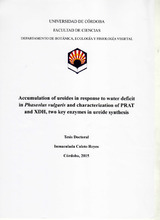Mostrar el registro sencillo del ítem
Accumulation of ureides in response to water deficit in Phaseolus vulgaris and characterization of PRAT and XDH, two key enzymes in ureide synthesis
| dc.contributor.advisor | Pineda Priego, Manuel | |
| dc.contributor.advisor | Muñoz Alamillo, Josefa | |
| dc.contributor.author | Coleto Reyes, Inmaculada | |
| dc.date.accessioned | 2015-12-16T11:07:54Z | |
| dc.date.available | 2015-12-16T11:07:54Z | |
| dc.date.issued | 2015 | |
| dc.identifier.uri | http://hdl.handle.net/10396/13172 | |
| dc.description.abstract | Los ureidos alantoína y alantoato son las formas mayoritarias en las que se almacena y transporta el nitrógeno fijado en los nódulos de las leguminosas tropicales o de tipo ureídico como la soja (Glycine max) y la judía (Phaseolus vulgaris). En las leguminosas ureídicas, el déficit hídrico produce la inhibición de la fijación de nitrógeno, a la vez que aumenta el contenido de ureidos en las hojas. La síntesis de ureidos se lleva a cabo por el catabolismo oxidativo de purinas que pueden haber sido sintetizadas de novo o proceder del reciclaje de los nucleótidos de purina. En este trabajo, se ha llevado a cabo un análisis del metabolismo de los ureidos en variedades de P. vulgaris con distinto grado de tolerancia a la sequía. La determinación del contenido de ureidos en los distintos genotipos de judía sometidos a estrés hídrico mostró que la acumulación de ureidos se correlacionaba con el grado de tolerancia a la sequía de los mismos, siendo mayor en los más sensibles. Además, la acumulación de ureidos se debía a la activación de su síntesis en tejidos diferentes a los nódulos. Para analizar la procedencia de los ureidos acumulados durante el estrés hídrico, se han estudiado las enzimas xantina deshidrogenasa (XDH) y glutamina fosforribosilpirofosfato amidotransferasa (PRAT), cruciales en la regulación de la oxidación y en la síntesis de novo de purinas, respectivamente. Se ha aislado la secuencia codificante y la región promotora del gen XDH de P. vulgaris, en la que se han encontrado diversos motivos de regulación por estrés. Los análisis de expresión y de actividad mostraron un aumento del nivel de PvXDH en respuesta a la sequía y a tratamientos con diferentes fitohormonas relacionadas con estreses abióticos o bióticos. Además de la actividad deshidrogenasa, la enzima PvXDH es capaz de catalizar la oxidación de la xantina y el NADH por oxígeno molecular. Sin embargo, solamente la actividad deshidrogenasa aumentó por el estrés. Curiosamente, el óxido nítrico (ON) produjo una inhibición de la actividad XDH en las hojas pero no en los nódulos de judía y la inhibición en hojas se impidió por ácido úrico añadido. Cuando se bloqueó la expresión del gen PvXDH por... | es_ES |
| dc.description.abstract | The ureides allantoin and allantoate are the mayor forms in which the nitrogen fixed in the nodules is stored and exported in tropical or ureidic legumes such as the soybean (Glycine max) and common bean (Phaseolus vulgaris). In ureidic legumes, nitrogen fixation is inhibited under water deficit, but the ureide content of leaves increases under these conditions. Ureide synthesis takes place by the oxidative degradation of purine bases, whose origin may be the de novo synthesis or the remobilization of preexisting purine nucleotides. In this work, an analysis of the ureide metabolism has been performed in several varieties of P. vulgaris with different degree of drought tolerance. The determination of the ureide concentration in different common bean genotypes subjected to water stress showed that the accumulation of ureides correlates with the degree of drought sensitivity of the varieties, being higher in the sensitive varieties than in the tolerant ones. Moreover, ureides accumulation was due to the activation of their synthesis in tissues other than nodules. To determine the origin of ureides accumulated during water deficit, the enzymes xanthine dehydrogenase (XDH) and glutamine phosphoribosylpyrophosphate amidotransferase (PRAT), which are pivotal in the regulation of the oxidation and de novo synthesis of purines, respectively, have been studied. The coding sequence and the promoter region of the XDH gene from P. vulgaris have been isolated. Analysis of the sequences revealed the presence of several stress-related regulatory motifs in the proximal promoter sequence and expression and activity analyses showed an enhancement in the PvXDH level in response to drought and in response to treatments with phytohormones related to abiotic and biotic stresses. Besides the dehydrogenase activity, the PvXDH protein is also able to catalyze the oxidation of xanthine and NADH by molecular oxygen; however, only the dehydrogenase activity increased in response to stress. Interestingly, nitric oxide (NO) inhibited the XDH activity in leaves, but not in nodules of common bean, and the inhibition in leaves was blocked by exogenous uric acid. When the expression of PvXDH gene was... | es_ES |
| dc.format.mimetype | application/pdf | es_ES |
| dc.language.iso | eng | es_ES |
| dc.publisher | Universidad de Córdoba, UCOPress | es_ES |
| dc.rights | https://creativecommons.org/licenses/by-nc-nd/4.0/ | es_ES |
| dc.subject | Ureidos | es_ES |
| dc.subject | Phaseolus vulgaris | es_ES |
| dc.subject | PRAT | es_ES |
| dc.subject | XDH | es_ES |
| dc.subject | Síntesis | es_ES |
| dc.subject | Déficit hídrico | es_ES |
| dc.subject | Ureides | es_ES |
| dc.subject | Synthesis | es_ES |
| dc.subject | Water deficit | es_ES |
| dc.title | Accumulation of ureides in response to water deficit in Phaseolus vulgaris and characterization of PRAT and XDH, two key enzymes in ureide synthesis | es_ES |
| dc.title.alternative | Acumulación de ureidos en respuesta al déficit hídrico en Pahseolus vulgaris y caracterización de la PRAT y la XDH, dos enzimas clave en la síntesis de ureidos | es_ES |
| dc.type | info:eu-repo/semantics/doctoralThesis | es_ES |
| dc.rights.accessRights | info:eu-repo/semantics/openAccess | es_ES |

